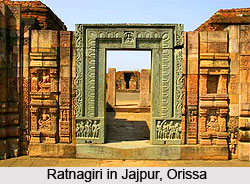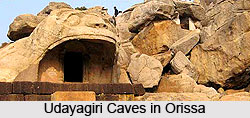 Buddhist trail and sites of Orissa bear witness to this fact that Buddhism originated in Orissa quite a long time back. Within the state a number of important sites like Kapilavastu, Bodhgaya and Sarnath in Orissa have developed that is closely associated with the life of Lord Budha. Orissa also has a vista of ancient scriptures of Buddha, scattered everywhere in the state. Rich tradition is enhanced by the legends popular amongst the people. These legends talk about the tooth relic of Buddha that is enshrined in the heart of Orissa. Pali texts that are found here refer to the connection of Buddha with two businessmen from Orissa. They are called Tapasu and Bhallika. Buddhist trails and sites of Orissa also have another aspect. The literacy references, myths, and historical data all bear proof of flourish of this religion in its most accepted form.
Buddhist trail and sites of Orissa bear witness to this fact that Buddhism originated in Orissa quite a long time back. Within the state a number of important sites like Kapilavastu, Bodhgaya and Sarnath in Orissa have developed that is closely associated with the life of Lord Budha. Orissa also has a vista of ancient scriptures of Buddha, scattered everywhere in the state. Rich tradition is enhanced by the legends popular amongst the people. These legends talk about the tooth relic of Buddha that is enshrined in the heart of Orissa. Pali texts that are found here refer to the connection of Buddha with two businessmen from Orissa. They are called Tapasu and Bhallika. Buddhist trails and sites of Orissa also have another aspect. The literacy references, myths, and historical data all bear proof of flourish of this religion in its most accepted form.
The aftermath of the famous Kalinga war, held in 261 B.C. was a path breaking one. It proved to be a landmark since it discerned the growth of Buddhism when emperor Ashoka metamorphosed into an ardent Buddhist believer. He was transformed into a benevolent king discarding all his cruelty and bloodshed. Under the initiative of Ashoka propagation activities spread to other countries as well. Christian missionaries were sent to far East and also to a number of South Asian countries. From the accounts of the famous traveller from China, Hiuen Tsang, one also can get acquainted with valid facts highlighting the growth of Buddhism in Orissa. It talks of the beautiful stupas made by Ashoka and later rulers, bell capitals and copper plates. Discovery of Buddhist figures and images also depict the exact scenario of the growth of Buddhism in the state.
Buddhist Circuit is the place that houses some of the most important Buddhist sites and trails of Orissa. Some of the most important include Ratnagiri, Lalitgiri, Udayagiri and close by Langudi Hills integrated in this circuit. Interestingly there is no such place in Orissa where a Buddhist figure or anything related to Buddhism is found.
 Ratnagiri
Ratnagiri
Lying on the Bripura riverbanks, almost hundred km away from Bhubaneshwar city, Ratnagiri is dotted with a rich variety of Buddhist antiquities. After a thorough excavation of the place various artefacts like Buddhist shrines, huge monasteries, a huge stupa and a handful of sacred stupas have been unearthed. Buddhism was born here in sixth century and developed to its fullest in the twelfth century A.D. In the days of its inception Buddhism gained popularity as a significant zone of Mahayana Buddhism. However during eighth and ninth century AD, Tantric Buddhism too flourished substantially in Ratnagiri. In the subsequent era, i.e. during tenth century A.D, it played an important part in the growth of `Kalachakra Tantra`.
Lalitgiri
Rich heritage of Buddhist trails and sites of Orissa can also be experienced at Lalitgiri. In fact Lalitgiri is considered one of the most primitive Buddhist complexes that dates back as early as first century A.D. Placed almost ninety km from Bhubaneshwar, it houses a large monastery made up of brick, innumerable votive stupas and remnants of a `chaitya` hall. A special attraction is a recreated stone stupa lying atop a rugged sandstone hill in the midst of lush greenery. In the adjoining area there is a sculpture-shed that exhibits exquisite images belonging to various Buddhist art schools. Recently in 1985, golden caskets have been excavated constituting sacred bone relics. Lalitgiri`s close link to Tathagata, increases the sanctity of the place to a great extent.
 Udayagiri
Udayagiri
It is one of the largest complexes that contain a plethora of Buddhist sites and trails of Orissa. Udayagiri is almost ninety km from Bhubaneshwar. Madhavapuar Mahavira was the name given to Udayagiri in the ancient period. It was constructed sometime between seventh and twelfth century A.D. It is situated in the catchments area of a U-shaped hillock. Udayagiri possesses a treasure of brick monasteries, a brick stupa, rock carved sculptures and also a stepped-well comprising an inscription. Antiquities like figures of Dhyani Buddha, Bodhisatva, Avalokiteswara, Tara, Jhambhala, Aparajita, Heruka etc. make Udaygiri a place of excellence.
Dhauli
Dhauli is earmarked as a haven of treasure of Buddhist trails and sites. Situated on the top of Dhauli Hills, Peace Pagoda or Shanti Stupa is an edifice immortalising the eventual victory of peace and non - violence accompanied by the transformation of Emperor Ashoka into a benevolent king after the Kalinga War. The Shanti Stupa is located at a distance of almost eight km from Bhubaneshwar. A monastery was also built underneath. Japan Buddha Sangha and Kalinga Nippon Buddha Sangha constructed both these structures in the 1970s.
Langudi
Nestled in the triangle of Lalitgiri-Ratnagiri-Udayagiri, Langudi is a hub that throws light on the Buddhist heritage and culture of Orissa. It is a fountainhead of antiquities like clusters of rock carvings, consecrated stupas, two exclusive figures of Buddha along with female devotees. Remains of a monastery, constructed of bricks, have cast a spell in the minds of those who visit the place in great jubilance. The most valuable discovery are the two inscribed figures of Emperor Ashoka. One of it displays Ashoka with 2 queens. All theses treasures enable the tourists to have a glimpse of the past heritage of ancient India.
Tracking down the findings of historians it can be said that development of Buddhism reached its peak during the rule of Bhauma kara Dynasty of eight to tenth century A.D. According to inscriptions from that period, a Bhaumakara Dynasty ruler replicated a text of Mahayana Buddhism and sent it as a gift to the Emperor of China. From the records of the pilgrims of China Hiuen Tsang and Fa- Hien, all the Buddhist schools like Mahayana and Hinayana flourished in full swing. A multitude of Buddhist scholars also acknowledge that Orissa was a hub of various types of Tantric Buddhism like Vajrayana, Kalachakrayanaand Sahajayana. Staunch Tantric Buddhists also believe that Orissa contributed in a substantial way to the development of the school of Buddhism. People of Orissa had ample scope to interact with the Tantric school of Tibet.



















